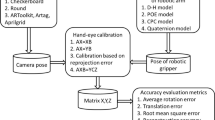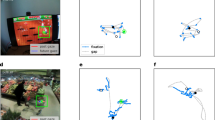Abstract
OKAS-3D is a further development of the single floating circle target tracker. This tracker consists of a cathode ray tube display, a lens in front of the display and a circular light-sensitive photocell placed in the image field of the lens. A small circular trace generated on the screen is focused around the photocell. The sinusoidal electrical output of the photocell contains all the relevant information regarding the position of the photocell relative to the image of the circular light trace. This gives the tracker the properties of a servo-controller with position feedback. In OKAS-3D three pairs of photocells are located on two lightweight frames attached to the upper and lower frontal teeth by individually adapted clutches. By using the formulas of rigid body mathematics, the motion of any point of the mandible can be reconstructed. The system permits a high sampling frequency of at least 300 Hz per photocell co-ordinate. The noise, linearity and accuracy are better than 0·08 mm, 0·07 mm and 0·13 mm for points in the lower incisal region, and better than 0·25 mm, 0·17 mm and 0·27 mm for points in the condylar region. Thus jaw movements can be recorded with a high spatial and temporal resolution.
Similar content being viewed by others
References
de Vries, J. H. (1980): ‘A concept for a floating circle target tracker’,Med. Biol. Eng. Comput.,18, pp. 213–219
Furnée, E. H. (1989): ‘TV/computer motion analysis systems: the first two decades’. PhD thesis, Delft Technical University, pp. 144–148
Hobo, S., andMochizuki, S. (1983): ‘A kinematic investigation of mandibular border movements by means of an electronic measuring system. Part I: development of the measuring system’,J. Prosthet. Dent.,50, pp. 368–373
Jankelson, B., Swain, C. W., Crane, P. F. andRadke, J. C. (1975): ‘Kinesiometric instrumentation: a new technology’,J. Am. Dent. Assoc.,90, pp. 834–840
Kang, D. W., Mongini, F., Rossi, F., Tempia-Valenta, G. andPedotti, A. (1993): ‘A system for the study of jaw movements’,J. Craniomandibular Pract.,11, pp. 63–67
Karlsson, S. (1977): ‘Recording of mandibular movements by intraorally placed light emitting diodes’,Acta Odontol. Scand.,35, pp. 111–117
Klett, R. (1982): ‘Elektronisches registrierverfahren für die kiefergelenksdiagnostik’,Dtsch. zahnärztl. Z,37, pp. 991–998
Lemmer, J., Lewin, A., andVan Rensburg, L. B. (1976): ‘The measurement of jaw movement. Part I’,J. Prosthet. Dent.,36, pp. 211–218
Mauderli, A. P., Lundeen, H. C., andLoughner, B. (1988): ‘Condylar movement recordings for analyzing TMJ derangements’,J. Craniomandib. Disord. Facial Oral Pain,2, pp. 119–127
Merlini, L., andPalla, S. (1988): ‘The relationship between condylar rotation and anterior translation in healthy and clicking temporomandibular joints’,Schweiz. Monatschr. Zahnmed.,98, pp. 1191–1199
Pröschel, P., Feng, H., Ohkawa, S., Ott, R., andHofmann, M. (1993): ‘Untersuchung zur interpretation des bewegungsverhaltens kondylärer punkte’,Dtsch. Zahnärztl. Z.,48, pp. 323–326
Siegler, S., Hayes, R., Nicolella, D., andFielding, A. (1991): ‘A technique to investigate the three-dimensional kinesiology of the human temporomandibular joint’,J. Prosthet. Dent.,65, pp. 833–839
Veldpaus, F. E., Woltring, H. J., andDortmans, L. J. M. G. (1988): ‘A least-squares algorithm for the equiform transformation from spatial marker co-ordinates’,J. Biomech.,21, pp. 45–54
Author information
Authors and Affiliations
Rights and permissions
About this article
Cite this article
Naeije, M., Van der Weijden, J.J. & Megens, C.C.E.J. OKAS-3D: optoelectronic jaw movement recording system with six degrees of freedom. Med. Biol. Eng. Comput. 33, 683–688 (1995). https://doi.org/10.1007/BF02510786
Received:
Accepted:
Issue Date:
DOI: https://doi.org/10.1007/BF02510786




